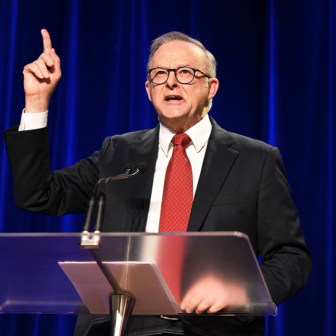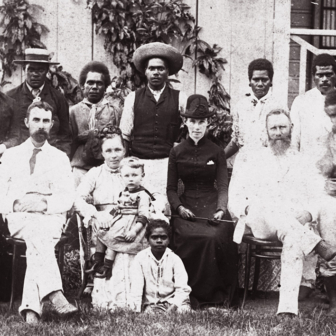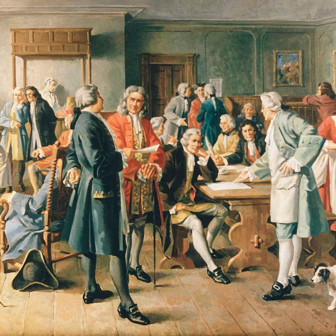African American journalist Vincent Tubbs had been reporting on lynchings in the South for the Baltimore Afro-American until the paper sent him to North Africa and the Pacific as a war correspondent. Reporting in 1944 from “somewhere in Australia,” he wrote that “Paul Robeson is undoubtedly the most popular colored American with Australians. Every third Australian met will want to know ‘Do you know Paul Robeson, Marian Anderson, Joe Louis?’”
It is for good reason, then, that “Australia and New Zealand Love Paul Robeson, 1925–1939” is the title of the first chapter of The Last Tour, Ann Curthoys’s remarkably well-researched account of the singer’s 1960 tour of Australasia with his wife Eslanda. An enthusiastic audience for his work had been built up via records, film and radio in Australia and New Zealand, as in so many parts of the world, since the late 1920s.
With extraordinary attention to detail, Curthoys guides us through the background and then each stage of the tour. Often, she is able to tell us who the Robesons met in a city, what they talked about, and how that person recalled the meeting years later. This rich detail makes The Last Tour a model microhistory and demonstrates how much can be gained from close study of one event when broadly contextualised and carefully interpreted.
This is also the story of Eslanda’s tour — she is present in every chapter and gets a chapter of her own as well. She was an LSE-trained anthropologist with extensive experience in Africa. On tour, Curthoys writes, she was by turns “an independent writer, journalist, anthropologist and advocate of women’s rights.” She gave public lectures — on Africa, China, the UN, decolonisation and peace — and later in the tour began to speak about Aboriginal rights.
The Australasian audiences had heard and seen less of Paul Robeson during the cold war 1950s, when he was to some extent disappeared from public view for his communist and pro-Soviet views — a “near erasure,” Curthoys writes, that was “swift and thorough.” From 1950 to 1958, Paul and Eslanda were denied US passports and thus lived under a form of “national arrest.” In Australia and New Zealand, too, Paul Robeson was less likely to be played on radio, seen in films or available in record stores in these years. From 1958, however, he resumed performing, with a concert at Carnegie Hall and one in London, both recorded and still widely available. When he was offered an attractive fee to tour Australia and New Zealand in 1960, he took the opportunity, partly to make up for lost income in the 1950s.
Robeson’s Australasian fans turned out in large numbers. The Afro-American reported from Melbourne that interest was so high that in addition to his three concerts at the “outsize Town Hall” he would also give a further concert at the 3500-seat Palais Theatre. The African American Chicago Defender noted that in Melbourne he “got the cheer treatment” even before beginning his performance, something “usually reserved here for teenage warblers,” yet “a large percentage of the capacity audience in the huge Melbourne Town Hall was made up of older age groups.” That age profile had an effect on the performances: “very often they asked him to sing songs he had not sung for years,” Curthoys notes, “and he had to remind himself of the words.”
But not the words of the most iconic Robeson songs — the ones he sang almost every time he performed. Ol’ Man River had been written by Jerome Kern with Robeson’s deep, resonant voice in mind. Performing it every night in the 1928–29 London season of Showboat he became “bored to death with it,” but it remained for the rest of his career the song audiences expected. In Australia and New Zealand Ol’ Man River and Joe Hill were saved for encores at the concerts but were always sung at the performances for workers — most famously the one for the builders of the Sydney Opera House.
For audiences in Australia and New Zealand, Robeson’s voice evoked not just the historical suffering of African American people but also something the singer, and perhaps they themselves, thought of as more universal. Curthoys reports that audiences in Australia and New Zealand loved him, but there was nevertheless a strain in being Paul Robeson night after night. A few months later, he wrote to a close friend that the tour “fulfilled its mission in a most complete way. The audience took me up at my own valuation and responded nobly” but nevertheless he felt “just tired out — Bored — to put it truthfully.”
African American singers in the classical music tradition had long been frustrated that (with a few prominent exceptions, such as Marian Anderson and Roland Hayes) they were restricted to performing identifiably African-American music rather than accepted as mainstream classical or operatic singers. NBC radio’s Major Bowes’ Amateur Hour, the most popular radio show in the US in the mid to late 1930s, provides a vivid example. On the very first episode the Major introduced an African American baritone and asked about his ambitions to be a concert singer:
“Another Roland Hayes, Paul Robeson, Eddie Matthews, huh? Well, in that case you either want to sing the Glory Road or Deep River or Water Boy — they all do… What do you want to sing?”
“Water Boy.”
“I thought so. Alright, come on.”
In contrast to the talent show hopefuls, Paul Robeson had become a star and could choose his own path. From the mid-1930s he was clear that the European classical music tradition was not his. The programs for the 1960 concerts were tilted towards folk music, broadly defined — including African American spirituals but also English, Irish, Russian and Jewish folk songs. Yes, he sang Bach, Beethoven, Mussorgsky, Dvorak and Bartok on the tour, but it was because these composers had turned to folk music for inspiration or had written music that (like the choral finale of Beethoven’s ninth symphony) celebrated universal fraternity and equality.
In the early years spirituals had dominated Robeson’s concerts. By 1960 they no longer did, but he continued to sing some in each concert. In his performances, Hazel Carby wrote in her 1998 book Race Men, “the spirituals were turned into an aesthetic commodity for white consumption.” Maybe that was true of his earlier career, but by 1960 Robeson was performing spirituals because he regarded them as folk music alongside the folk music of many other traditions. He told a BBC interviewer in 1963 that the inclusion of spirituals in his programs had changed — they were there now to show “the unity, the relation, of Negro music to all the music of the world.”
For Paul Robeson, folk music had high political importance because of its universalism. In his 1958 book Here I Stand he talked about a “world body — a universal body — of folk music” that connected the working people of the world through shared values. This was a common belief in the popular-front left, but Robeson took it further than most, developing his own theories about folk music’s universality. His son recalled Paul working on “a general theory of music that linked classical Western harmony to the universal pentatonic scales of folk music.”
As Robeson explained as early as 1939: “When I sang my American folk melodies in Budapest, Prague, Tiflis, Moscow, Oslo, the Hebrides, or on the Spanish front, the people understood and wept or rejoiced with the spirit of the songs. I found that where forces have been the same, whether people weave, build, pick cotton, or dig in the mines, they understand each other in the common language of work, suffering and protest.” Robeson’s political and aesthetic beliefs were universalist in this way. He demonstrated the theory in each concert, and the proof lay in the warm response of audiences to folk music he sang in twelve different languages. One critic, Grant Olwage, has labelled his performances in this period an “(oppositional) cosmopolitics” — a form of emotional and performative internationalism.
Two themes emerge most strongly from Curthoys’s book. One is about the international links communism forged through the peace and international labour movements. So many of the people Paul and Eslanda met were unionists, communists, peace activists or more than one of those. The key organisations included the Building Workers Industrial Union, the Waterside Workers Federation, the Australian Peace Council and the Union of Australian Women.
The outdoor concert at the Sydney Opera House site is the best remembered of his performances for union workers but there were others, including to 2000 railway workers in Perth, 1000 waterside workers at Port Adelaide and 4000 waterside workers in Melbourne. These groups always got the three iconic songs — Ol’ Man River, Water Boy and Joe Hill — and a talk. The political and emotional impact was strong. Wally Stubbings, a Brisbane waterside worker and unionist who met the singer, recalled how Robeson “talked of the struggle of his people… I almost wept at his description.”
One of Curthoys’s biggest contributions is her careful documenting of the sustained attention the Robesons gave to Indigenous people and issues in Australia and New Zealand. The couple’s introductions to Indigenous leaders via the communist and peace movement worked better in some cities, Curthoys observes, than in others. But both Paul and Eslanda clearly understood the struggles for Māori and Aboriginal rights they glimpsed as part of a global anti-colonial movement.
In Sydney, the civil rights activist Faith Bandler arranged for Paul and Eslanda to see two films about Aboriginal people in Western Australia, after which Paul, “angry and upset,” had tears in his eyes. Eslanda visited the community at La Perouse, on Sydney’s Botany Bay. Paul and Eslanda both spoke on Indigenous issues at Paddington Town Hall. “Regardless of colour, race, background, religious beliefs, political ideas,” Eslanda told them, “we are members of the human family… This is very important because this is a matter of peace or war.” Paul said matter of factly to a television interviewer that Australia’s wealth came originally from taking the land: “You just came and took it… And that’s what they did in most countries.”
While their tour “certainly helped the peace movement,” Curthoys concludes, its greatest legacy “was an enhanced determination by left-wing activists to support the struggle for Indigenous rights.” Ann’s mother Barbara Curthoys (one of the people to whom the book is dedicated) was among the communist activists who took up this challenge, giving a report on Aboriginal policy to the Union of Australian Women in 1961; and Ann herself went on Charles Perkins’s Freedom Ride in 1965. This is also a personal book.
The Last Tour is written with assured steadiness and depicts steadiness in its subjects. The Robesons emerge as people with deep and abiding political commitments and a consistent resolve to explain them. A coherent picture emerges of their universalist politics — about equality, civil and human rights, anti-colonialism, the fraternity of working people everywhere — a reminder perhaps of a time when these big themes could more confidently be canvassed.
That steadiness extended to their communist affiliations. They clung to their beliefs through the events of the mid-1950s — Khrushchev’s secret speech denouncing Stalin; the Soviet invasion of Hungary — that provoked many in the West to leave the movement. (Paul told the first press conference in Sydney that it had been necessary for the Soviet Union to suppress a fascist revolution in Hungary.) Curthoys reports all of this unflinchingly but doesn’t allow it to dominate. She also mentions but doesn’t dwell on the pain Paul felt at being sidelined by a younger generation of African American civil rights leaders.
Of course somewhere beneath this steadiness of purpose and consistency of ideas there was also crisis, churn and anxiety. Biographers have long documented these stresses, including the tensions between Paul and Eslanda and the exhaustion and despair that led Paul to attempt suicide in Moscow only a few months after their return from Australia. All of that is acknowledged in this book but is not its primary focus. The Robesons are the central characters but the aim is not biography.
Recent work by Shana Redmond, Grant Olwage and other scholars offers more complex readings of Paul as a performer, finding strains of performative modernism and cosmopolitanism and much else. That is also acknowledged but not central to this book. What the book does do is immeasurably broaden our understanding of this tour as an event in its historical moment and richly situate it in its national, transnational and international contexts.
Historian Marilyn Lake is quoted on the cover describing The Last Tour as “political history at its best.” One of its achievements is demonstrating how a political history extending well beyond government, leaders and elections into this kind of transnational, cultural and social movement history can open up new lines of vision on our past. •
The Last Tour: Paul and Eslanda Robeson’s visit to Australia and New Zealand
By Ann Curthoys | Miegunyah Press | $39.99 | 400 pages




